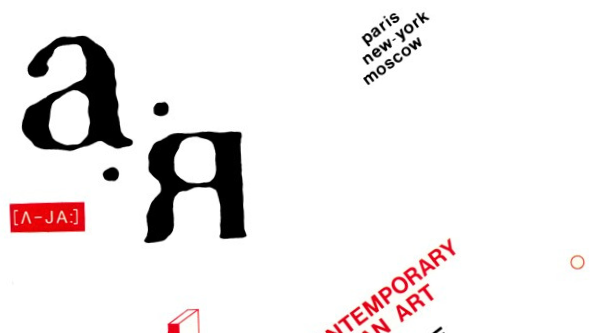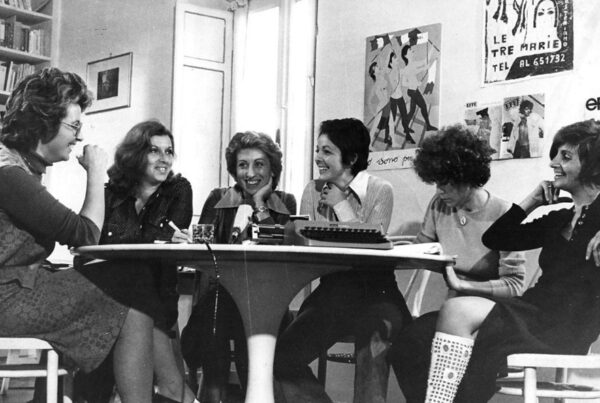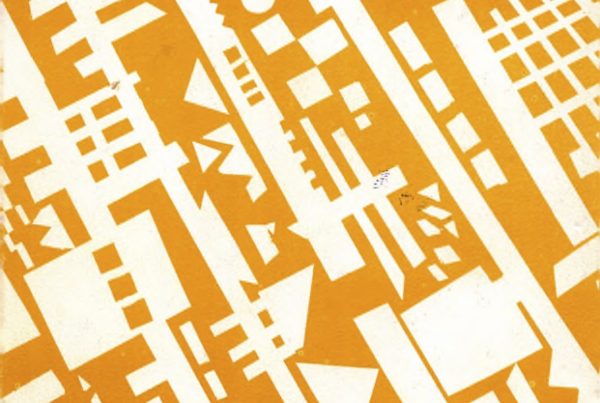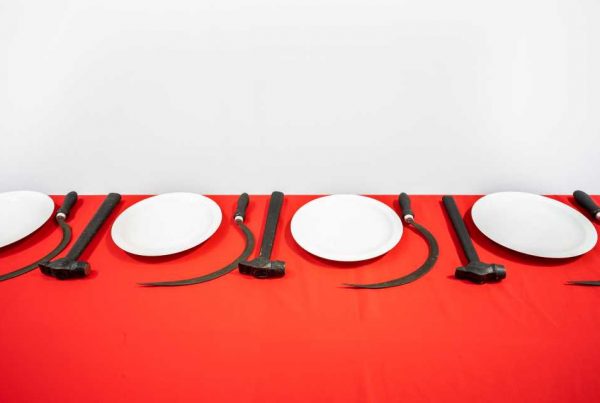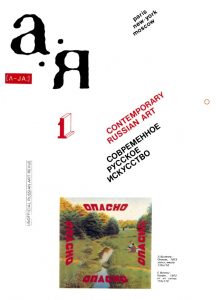
The cover of the first issue of “A-Ya”, 1979. Source: “Vtoraia Literatura”.
Title of the journal:
“A-Ya”
Dates: 1979-1986
Place of publication: Paris
Editors: Aleksandr Sidorov under the pseudonym Aleksei Alekseev, Igor’ Shelkovskii, and Aleksandr (Alexander) Kosolapov (1981-1984). From 1981 to 1986 the journal also had an editorial board on which sat the artist Sergei Esaian (Sergei Essaian) from Paris, the translator Jamey Gambrell from New York, art historians and critics Irina Baskina from Paris, Igor’ Golomshtok (Igor Golomstock) from London, Boris Grois (Groys) from Moscow (1981), Munich (1982-84) and Cologne (1986), and Margarita Tupytsina (Tupytsin) from Washington (1981) and New York (1982-86)
Main collaborators: Over the years, several correspondents from abroad joined the editorial staff. Mainly émigré artists, those who contributed included Kosolapov from the United States (1980-81), Mikhail Kulakov (Koulakov) from Italy (1980-86), Mikhail (Michael) Grobman from Israel (1980-86), Vadim Kosmachëv (Kosmatchof or Kosmatchev) from Austria (1981-84) and art historian Golomshtok from the United Kingdom (1981-86). The journal also had representatives in Japan (1980-86) and Switzerland (1981-82)
Total number of issues: eight, printed yearly, including a “literary issue” in 1985 on contemporary Russian literature, edited by Inna Rakuzina and Elena Zhurova. This issue was conceived as the first of a new – but never continued – series. In 1986, the seventh and last issue of “A-Ya” on the arts was published.
Description:
“A-Ya” was the most important unofficial journal on Soviet art, edited in Moscow by photographer and graphic designer Aleksandr Ivanovich Sidorov (Moscow 1941-2008), and in Paris by emigré artist Igor’ Sergeevich Shelkovskii (Orenburg 1937). Although the first issue announced that the journal would be published biannually, it was always published on a yearly basis. In the first issue, the magazine’s title is transliterated as “A-Ja”, while in the remaining issues as “A-Ya”. Each issue is bilingual, printed in Russian with English translations edited by Jamey Gambrell (1980-1983), Todd Bludeau (1984), Bludeau and Nicola Verdy (1986). Each issue contains sixty pages printed in black and white on A4 paper, with selected colour plates featuring artwork reproductions. The first issue declares a print run of 7000 copies, while the following issues report 3000 copies. The first two issues show the cover price in major Western currencies.
The name of the journal has three meanings: “A” and “Ia” are the first and last letters of the Russian alphabet, the letters are an acronym for “post office box”, and, as a semantic unit, A-Ya means “but I”. The title thus lends itself to multiple readings. First, it exemplifies the journal’s mission to offer an exhaustive overview, from A to Z, of new Soviet art; second it signifies a private, underground, form of circulation through confidential channels to anonymous post office boxes; third, it voices a deliberate distancing from aesthetic conformism in the USSR. “A-Ya” did not set out to lay foundations for an unofficial art market, which by the late 1970s already existed. Rather, it intended to popularize the works of the Sots-artists and Moscow Conceptualists, which consisted mainly of dematerialized media such as aktsii (literally “actions”, performances, happenings, and environmental interventions), installations, and conceptual poetry. The editorial published in the first issue explains the journal’s mission in providing an overview of the main trends and personalities within unofficial Soviet contemporary art (an intention underlined in the parallel English title “Unofficial Russian Art Revue” [sic]), while its readership is envisaged as broad and diverse, including Russian artists (both in and outside of the USSR), art enthusiasts and critics. The magazine did not represent any specific artistic group or aesthetic orientation, but covered new and independent voices whose opinions “did not necessarily reflect those of the editors and publisher”. In order to protect artists living in the USSR, the editors claimed to publish their texts and works without their knowledge. On the front cover of the first issue was the painting Opasno (Danger, 1973) by Erik Bulatov, whose interview with Groys featured in the magazine. On the inside cover was a photograph taken at the famous exhibition organized by nonconformist artists outside Moscow on September 15, 1974, which was torn down by bulldozers. There followed Boris Groys’ essay-manifesto Moskovskii romanticheskii kontseptualizm (Moscow Romantic Conceptualism), already published in the samizdat journal “37”, which represented a theoretical milestone within unofficial Soviet culture in that it gave the first comprehensive overview of leading underground personalities such as Lev Rubinshtein, Ivan Chuikov, Frantsisko Infante and the Kollektivnye deistviia (Collective Actions) group.
From the very first issue in 1979, the editors clearly stated their unconditional and programmatic support for unrecognized, banned or persecuted Soviet artists, by publishing autobiographical texts, full-page reproductions of works and critical essays by third parties. There were also pieces on the philosophy and theory of art, reviews of books and exhibitions, and interviews with Western artists (such as Joseph Beuys in the 1980 issue). “A-Ya” was devoted to the rediscovery of the Russian avant-garde and to post-modern critiques of Soviet visual culture, including Socialist Realism. In order to build bridges between the USSR and the West, the journal supported intercultural exchange (the first issue, for example, presented personal accounts of the exhibition “Paris-Moscow 1900-1930” held at the Centre Georges Pompidou in 1979 and two years later in Moscow, as well as an article by Aleksandr Kosolapov on Jasper Johns).
The pivotal role of “A-Ya” – conceived as a magazine “by artists and for artists” – in popularizing alternative Soviet art and visual culture in the last decade of the USSR’s existence has been recognised in our own century. The journal’s founders and chief-editors, Sidorov and Shelkovskii were awarded the “Innovation prize” in 2008 for their “contribution to the development of contemporary art”. In 2004, the magazine “Artkhronika” reprinted the eight issues of “A-Ya” edited by Shelkovskii and art historian Ol’ga Obukhova. On the “Vtoraia Literatura” website, all issues are available for searches and download.
Matteo Bertelé
[31st December 2022]
Bibliography
- “A – Ya” (zhurnal), https://vtoraya-literatura.com/razdel_2004_str_1.html, online (last accessed: 31/12/2022).
- Bertelé M., A-Ja. Unofficial Russian Art Review, in Enciclopedia dell’arte contemporanea, Treccani, vol. 1, Roma 2021: 62-63.
- Parisi V., Writing about apparently Nonexistent Art. The Tamizdat Journal “A-Ja” and Russian Unofficial Arts in the 70s-80s, in F. Kind-Kovács, J. Labov (eds.), From Samizdat to Tamizdat. Transnational Media During and After Socialism, Berghahn, New-York-Tokio 2013: 190-205.
- Parisi V., Il lettore eccedente. Edizioni periodiche del samizdat sovietico, 1956-1990. Il Mulino, Bologna 2014.
- Skarlygina E., Zhurnalistika russkoi ėmigratsii: 1960-1980-e gody, Moskva 2010.
To cite this article:
Matteo Bertelé, A-Ya, in Voci libere in URSS. Letteratura, pensiero, arti indipendenti in Unione Sovietica e gli echi in Occidente (1953-1991), a cura di C. Pieralli, M. Sabbatini, Firenze University Press, Firenze 2021-, <vocilibereurss.fupress.net>.
eISBN 978-88-5518-463-2
© 2021 Author(s)
Content license: CC BY 4.0
